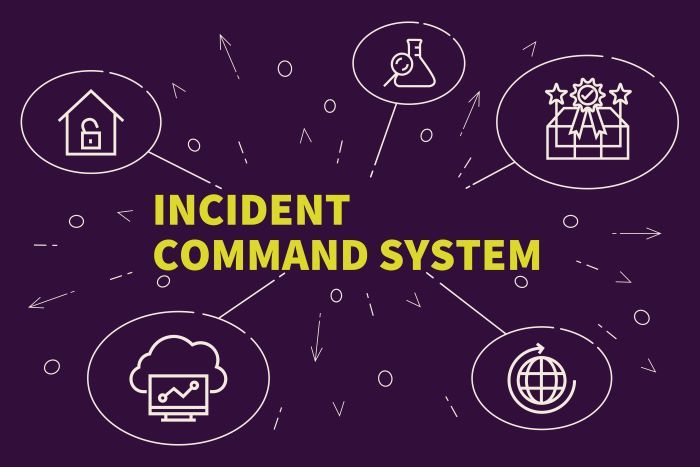
Though the clinical settings at standard healthcare facilities have some inherent differences from one another, healthcare providers working traditional locum tenens jobs are generally accustomed to functioning within a certain hierarchical structure of management at each facility. Many healthcare professionals working on their first locum humanitarian aid, emergency response, disaster relief, or government assignment are surprised to find that the new setting and varied accessibility to tools and technology are not the only aspects of the assignment they’ll have to get used to.
One of the biggest differences between traditional locum assignments and locum crisis projects is that instead of using a conventional hierarchical structure of management, they use a highly standardized management tool called the Incident Command System, (ICS).
ICS is a United States military-based, top-down management structure used during incident response of any severity, which supersedes the management structures of any other organization or agency that is responding to the event. It standardizes terminology, position titles, and responsibilities, clearly delineating the responsibilities of all personnel. ICS has become the U.S. standard for emergency management, representing best practices and establishing common processes for the planning and management of resources.
So how is this information helpful if you don’t know how ICS actually works in a real-world emergency response assignment? Thanks to FEMA’s Emergency Management Institute (EMI), there are three ICS courses available for providers looking to prepare for their first locum crisis project, and anyone else involved with emergency planning and recovery or response efforts. Not only are the courses easily accessible online, but they are free of cost and offer the opportunity to gain a certification from FEMA after completion of the series.
ICS courses 100, 200, and 700 significantly helped one of Wellhart’s nurse practitioners, Angie Oliver, when she worked with us on our Unaccompanied Minors – US/Mexico Project, “Once I did those 3 courses it opened up a whole light to me. Everybody that I trained from that point on, when I showed them how we were in the hierarchy, they were able to find their niche and fit in just fine”.
EMI Course Overviews
Introduction to the Incident Command System, ICS 100
EMI’s Introduction to the Incident Command System course is exactly what it sounds like: an introduction to the Incident Command System which also provides a foundation for EMI’s higher level courses about ICS. It gives historical context for ICS, and describes its features, principles, and organization structure.
This 2 hour introductory course also explains the connection between the Incident Command system and NIMS, or the National Incident Management System, which is covered in more detail in FEMA’s 700 course, which we will also overview below.
Upon your completion of the Introduction to the ICS you should be able to describe General Staff roles within ICS, ICS functional areas as well as the roles of the Incident Commander and Command Staff, and how NIMS management characteristics are used in ICS for different discipline areas and roles.
Basic Incident Command System for Initial Response, ICS 200
The Basic Incident Command System for Initial Response course provides a refresher on the Incident Command System, and provides further context for how ICS works within initial response. This course builds upon the knowledge you learned in the 100 course and prepares you for higher level ICS training after completion of the 200 course.
If you know you are going to, or are likely to assume a supervisory role on your locum crisis project with Wellhart, this 4 hour course provides training and resources specifically for personnel at the supervisory level within the ICS management structure.
This course will further inform you on the interrelation between ICS and NIMS, and the processes for the implementation and delegation of authority, preparedness plans and objectives, and management by objectives. You will also learn about the different types of meetings and briefings, ICS organizational components, ICS staff and tools, the flexibility within the ICS structure, and, most importantly, how to use ICS to manage an event or incident.
IS-700.B: An Introduction to the National Incident Management System
FEMA’s Introduction to the National Incident Management System course delves deeper into NIMS, providing an overview of the system and defining the comprehensive approach which guides all levels of government, the private sector, and nongovernmental organizations (NGO) on how to seamlessly work together to prevent, mitigate, protect against, respond to, and recover from emergency events.
The 3.5 hour course is aimed to teach learners about the key concepts, principles, applicability, and scope of NIMS, the activities and methods regarding resource management, NIMS management characteristics. It also introduces and teaches about Emergency Operations Center (EOC) functions, interconnections between NIMS and other Coordination structures, and crisis communication.
An Introduction to the National Incident Management System has no prerequisites and was created for a wide reaching audience including government executives, law enforcement, private-sector and NGO leaders, emergency management practitioners, and any other individuals with emergency management responsibilities.
Feel more confident when going on response and recovery assignments through Wellhart with your comprehensive knowledge of ICS, NIMS, and everything in between!
To hear about your first crisis assignment, fill out our contact form and your new recruiter will be in touch shortly!
